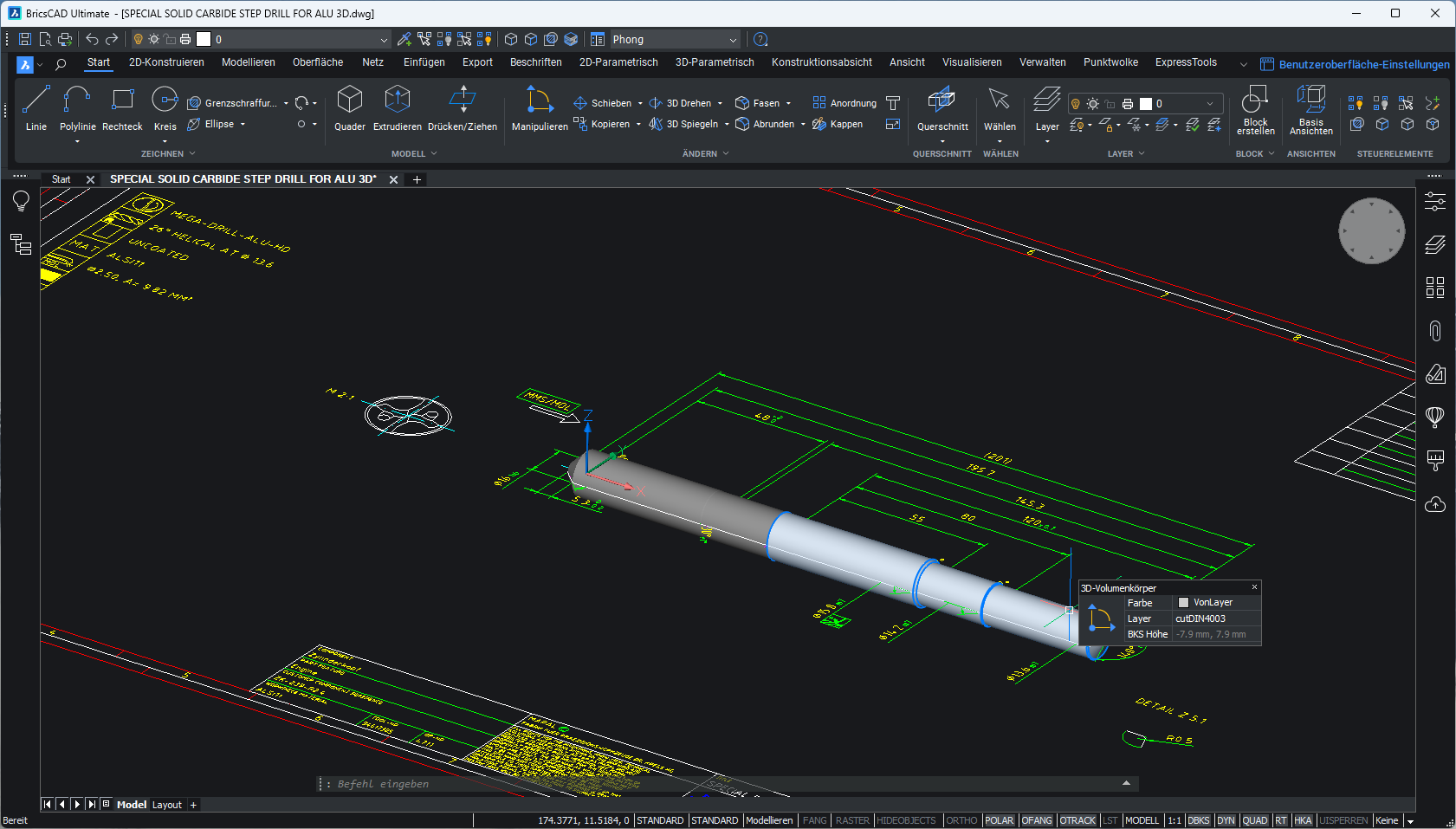MAPAL, a global technology leader in precision tools and solutions for metal machining processes, chose BricsCAD® because of its DWG compatibility, cost-effectiveness, and support for in-house development based on LISP and C++. BricsCAD has been a valuable tool for MAPAL and has transformed their efficiency and productivity in their projects.
Founded in 1950 by Dr Georg Kress as a manufacturer of tap drills and woodworking machines, MAPAL has grown into a global technology leader in precision tools and solutions for metal machining processes, with over 5000 employees in 25 countries. The company offers a diverse portfolio that spans critical sectors such as aerospace, automotive, and die and mould, as well as the fluid power technology sector. MAPAL supplies these industries with high-performance specialist tooling tailored to their manufacturing needs and intelligent services to ensure precision, reliability, and cost-effectiveness.
Marcus Funk was the initiator and person in charge of MAPAL’s adoption of BricsCAD® and has been heavily involved in MAPAL’s journey with BricsCAD since its implementation in 2009. Marcus is responsible for 2D CAD systems and is MAPAL’s Systems Administrator and Software Developer (LISP and C++) for Digital Operations/ CAx applications, working with Ralf Wackenhut, Vice President of Design and Digital Operations.

The Challenge
In 2009, amid a global financial crisis, Marcus was tasked with finding a DWG-compatible, more cost-effective CAD solution. This initiative was significant considering the needs of 450 field sales and 150 inside sales personnel who required access to a CAD tool and a platform to integrate with in-house developed applications. AutoCAD® LT, their solution at the time, did not support the ability to execute LISP routines, which was a fundamental requirement for them. Marcus looked at several alternatives and discovered that BricsCAD’s support for LISP files and comprehensive API would enable in-house applications and ensure a strong integration with BricsCAD.
In Marcus’s words:
“I started searching for DWG-supporting systems, and yes, there were many systems that I had a close look at, but BricsCAD had the best support on handling the LISP files that we had. We had a big bunch of LISP applications to create our tools and so the decision went to BricsCAD.”
In addition to BricsCAD’s LISP capabilities and robust API, Marcus highlighted the excellent support MAPAL received from Bricsys® technical staff. This support extended to both general assistance and specific development requests. Reflecting on this, Marcus shared:
“I’m happy that we decided to use BricsCAD in the company because of the great support, and it was the right decision for sure.”
The Solution
Enhanced System Integration for Automation
BricsCAD – More Than a CAD System:
BricsCAD transcends its role as a CAD system for MAPAL; it serves as a comprehensive platform for in-house developed applications in LISP, C++, and C#. This includes internal and external configurators for MAPAL tools, a block library application, and more. This extensive system integration ensures a high automation rate, minimizing user errors.
Digital Assistant for Design Drafts:
Beyond conventional CAD functionalities, BricsCAD is a digital assistant in the design and dimensioning of MAPAL tools. This functionality significantly contributes to resilient design drafts, ensuring accuracy and precision in the tooling process.
SAP® Direct Integration:
A noteworthy aspect of the system integration is BricsCAD’s direct integration with SAP® for document management—a critical element given SAP’s widespread use in enterprise resource planning (ERP). This seamless collaboration enhances MAPAL’s efficiency in managing and organizing project documents, contributing to a more streamlined workflow.

Sales Quote Generation
MAPAL encountered several obstacles when generating initial sales quotes for their specialized tooling. The company required a software solution capable of importing various file types and compatibility with their existing Mechanical 2D drawings while remaining cost-effective. BricsCAD emerged as the ideal choice, fulfilling these needs and more. With BricsCAD, MAPAL can efficiently and accurately produce sales quotes that meet customers’ specifications.
While crafting these initial sales quotes, BricsCAD is an integral sales support tool within MAPAL’s technical quoting system. Its primary role involves processing initial product design data to determine and plan the necessary steps to fulfil customer requirements. After a customer approves a quote, the project moves to the design department for further development in Creo®.
Import of Multiple File Types
Initial customer product design data comes in various formats, including 2D and 3D, DWG, DXF, PDF, and STEP files. This diversity is why BricsCAD is the preferred choice, as it allows importing all these formats through Communicator for BricsCAD®.
Marcus Funk, System Administrator and Software Developer for Digital Operations/CAx at MAPAL, explains:
“We use various formats, including PDFs, DWG, and DXF, to get dimensions and details. But the best method is to explore the 3D models with Communicator for BricsCAD to understand how to create the tool effectively.”
Legacy Library Interoperability
MAPAL possesses a vast collection of legacy AutoCAD® Mechanical 2D drawings for tooling, created before the shift to 3D design in Creo®. The task of “converting” these 2D drawings into 3D models is resource-intensive, and MAPAL believes that these resources could be better used for new designs. This situation underscores the need for not only accessing but also updating and editing these legacy 2D drawings.
To address this, MAPAL employs BricsCAD, due to its compatibility with AutoCAD® Mechanical. This allows MAPAL to maintain the features and functions of its legacy DWG libraries without the need to recreate them. Marcus further emphasizes this industry-wide requirement for compatibility with legacy CAD drawing libraries:
“The tools were already or are still designed in 2D, mostly legacy tools that are not worth recreating in 3D. These are 2D design drawings based on AutoCAD® Mechanical and to update and edit the drawings, we need the possibilities of BricsCAD, and I think we are not the only company that needs these possibilities.”
The ongoing collaboration between MAPAL and Bricsys promises to benefit the manufacturing industry substantially. This partnership is driven by continuous innovation, responding to honest user feedback, and leveraging the widely used 2D interoperability workflow.
Results
MAPAL’s use of BricsCAD has contributed significantly to improving their efficiency, lowering costs, and simplifying and automating their design and quoting processes. The software’s ability to work with various file formats, its interoperability, and its role as an integrated platform for in-house developed applications have made it a valuable tool in contributing to MAPAL’s ongoing success.
To see how BricsCAD® can support your company’s success, download a free 30-day trial today.
Autodesk®, the Autodesk® logo, AutoCAD® LT and AutoCAD® Mechanical are registered trademarks of Autodesk®, Inc., and/or its subsidiaries and/or affiliates in the USA and/or other countries.
PTC, Creo® are registered trademarks of PTC Inc. or its subsidiaries in the U.S. and in other countries.
Source: Bricsys Blog


 Tiếng Việt
Tiếng Việt